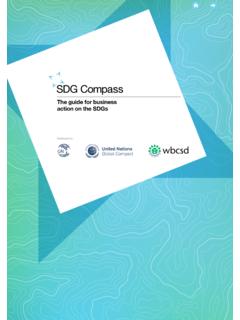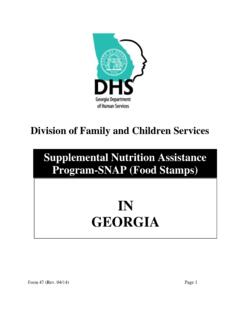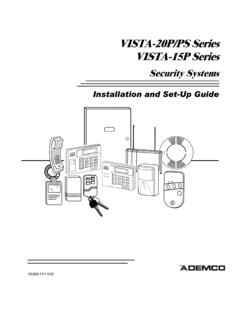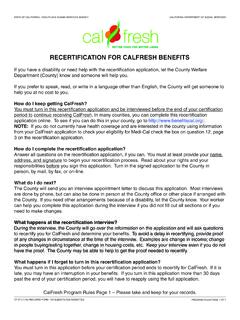Transcription of Advisory - Federal Aviation Administration
1 Department of Transportation Federal Aviation Administration Advisory Circular Subject: Use of Suitable Area Navigation (RNAV) Systems on Conventional Routes and Procedures Date: 3/3/11 Initiated by: AFS-400 AC No: 90-108 Change: 1. PURPOSE. This Advisory circular (AC) is intended for the following purposes. a. Operational and Airworthiness Guidance. Provides operational and airworthiness guidance regarding the suitability and use of RNAV systems while operating on, or transitioning to, conventional, , non-RNAV, routes and procedures within the United States ( ) National Airspace System (NAS).
2 This guidance material applies to two broad categories: (1) Use of a suitable RNAV system as a Substitute Means of Navigation when a very high frequency (VHF) Omni-directional Range (VOR), Distance Measuring Equipment (DME), Tactical Air Navigation (TACAN), VOR/TACAN (VORTAC), VOR/DME, non-directional radio beacon (NDB), or compass locator facility including locator outer marker and locator middle marker is out-of-service, , the Navigation Aid (NAVAID) information is not available; an aircraft is not equipped with an automatic direction finder (ADF) or DME; or the installed ADF or DME on an aircraft is not operational.
3 For example, if equipped with a suitable RNAV system, a pilot may hold over an out-of-service NDB. (2) Use of a suitable RNAV system as an Alternate Means of Navigation when a VOR, DME, VORTAC, VOR/DME, TACAN, NDB, or compass locator facility including locator outer marker and locator middle marker is operational and the respective aircraft is equipped with operational navigation equipment that is compatible with conventional NAVAIDs. For example, if equipped with a suitable RNAV system, a pilot may fly a procedure or route based on operational VOR using that RNAV system without monitoring the VOR.
4 B. Qualified RNAV Systems. Describes the types of RNAV systems that qualify as suitable RNAV systems as adopted in the final rule titled, Area Navigation (RNAV) and Miscellaneous Amendments, published in the Federal Register (FR) on June 7, 2007, which amended the Title 14 of the Code of Federal Regulations (14 CFR) sections listed in paragraph 2 of this AC. c. Operations on Certain Segments of ILS Procedures. Describes a suitable RNAV system for operations on published RNAV segments of certain instrument landing system (ILS) procedures. d. Alternative Compliance Method. In lieu of following the methods described in this AC, , the operating requirements detailed in this document, without deviation, operators may AC 90-108 3/3/11 Page 2 Par 1 follow an alternative method, provided the alternative method is acceptable by the Federal Aviation Administration (FAA).
5 NOTE: This AC does not address the use of RNAV systems on RNAV routes and RNAV terminal procedures. The current edition of AC 90-100, Terminal and En Route Area Navigation (RNAV) Operations, applies to those operations. This AC also does not address the use of RNAV systems on instrument approach procedures (IAP) titled RNAV (GPS) and GPS. The current edition of AC 90-105, Approval Guidance for RNP Operations and Barometric Vertical Navigation in the National Airspace System, applies to those operations. The RNAV systems and procedures specified in this AC and the current edition of AC 90-45, Approval of Area Navigation Systems for Use in the National Airspace System, are appropriate references for off-airway RNAV, random RNAV routes, or the Navigation Reference System (NRS).
6 2. RELATED 14 CFR PARTS. Part 1, Definitions and Abbreviations, , General Definitions. Part 91, General Operating and Flight Rules, , Operations in Class B Airspace, , Takeoff and Landing under IFR, , Powered Civil Aircraft with Standard Category Airworthiness Certificates: Instrument and Equipment Requirements, , Special Rules for Foreign Civil Aircraft. Part 121, Operating Requirements: Domestic, Flag, and Supplemental Operations, , Radio Equipment for Operations under VFR Over Routes Not Navigated by Pilotage or for Operations under IFR or Over-the-Top. Part 125, Certification and Operations: Airplanes Having a Seating Capacity of 20 or More Passengers or a Maximum Payload Capacity of 6,000 Pounds or More and Rules Governing Persons On Board Such Aircraft, , Communication and Navigation Equipment.
7 Part 129, Operations: Foreign Air Carriers and Foreign Operators of Aircraft Engaged in Common Carriage, , Aircraft Communication and Navigation Equipment for Operations under IFR or Over-the-Top. Part 135, Operating Requirements: Commuter and On Demand Operations and Rules Governing Persons On Board Such Aircraft; , Communication and Navigation Equipment: Extended Over-Water or IFR Operations. 3. DEFINITIONS. For the purposes of this AC, the following definitions are provided. a. Alternate Means of Navigation. The use of information from a RNAV system in lieu of that from operating conventional NAVAIDs and navigation equipment that is installed, operational and compatible with conventional NAVAIDs.
8 3/3/11 AC 90-108 Par 3 Page 3 b. Area Navigation (RNAV). A method of navigation which permits aircraft operation on any desired flight path within the coverage of ground or spaced-based navigation aids or within the limits of the capability of self-contained aids, or a combination of these. c. DME/DME/Inertial (DME/DME/IRU) RNAV. Refers to navigation using DME ranging from at least two DME facilities to determine position along with use of an integrated Inertial Reference Unit (IRU).
9 DME/DME/IRU airworthiness performance criteria is provided in the current edition of AC 90-100. d. Global Navigation Satellite System (GNSS). A worldwide position and time determination system, which includes one or more satellite constellations, aircraft receivers, and system integrity monitoring. GNSS is augmented as necessary to support the required navigation performance for the actual phase of operation. e. Global Positioning System (GPS). The GNSS core satellite constellation providing space-based positioning, velocity, and time. GPS is composed of space, control, and user equipment elements.
10 F. Receiver Autonomous Integrity Monitoring (RAIM). A technique used within a GPS receiver/processor to monitor GPS signal performance. This integrity determination is achieved by a consistency check among redundant measurements. g. Substitute Means of Navigation. The use of information from an RNAV system in lieu of that from out-of-service conventional NAVAIDs and/or inoperative or not-installed navigation equipment compatible with conventional NAVAIDs. h. Suitable RNAV System. An RNAV system that (1) meets the required performance established for a type of operations, for example, instrument flight rules (IFR); and (2) is suitable for operation over the route to be flown in terms of any performance criteria (including accuracy) established by the air navigation service provider for certain routes, for example, oceanic, ATS routes, and IAPs.


















